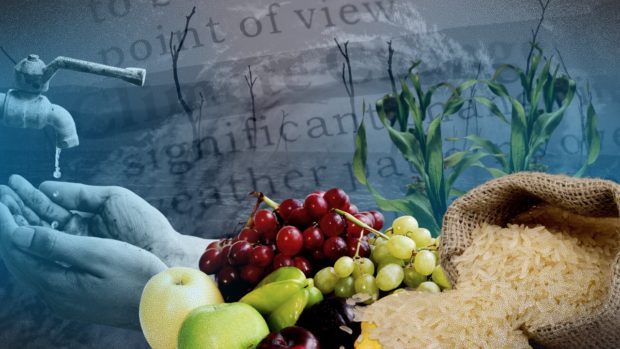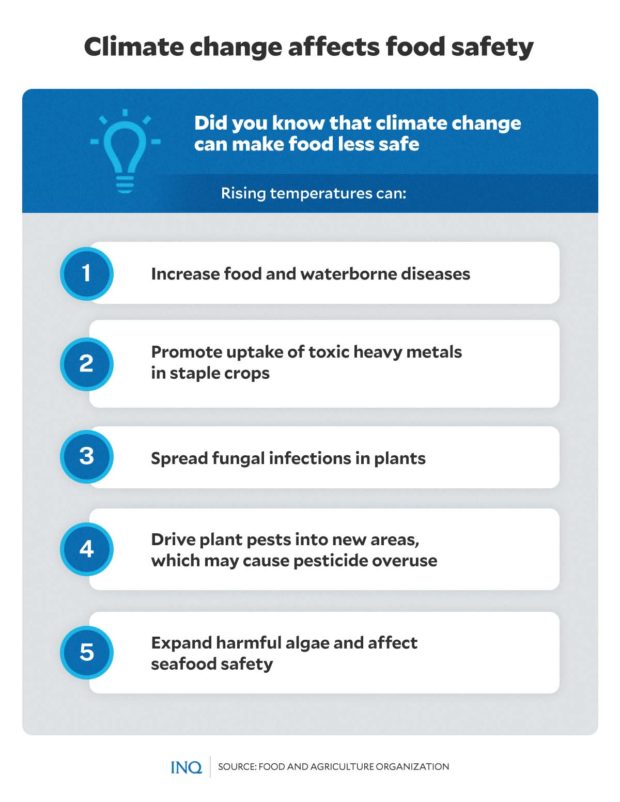FAO warning: Climate change poisons food
MANILA, Philippines—Did you know that aside from impacting the world’s food security, the rapidly accelerating climate crisis also affects food safety?
As world leaders gather this week and deliver speeches and meet for the 27th Conference of the Parties (COP 27) climate summit, one of the most significant impacts of climate change highlighted by the Food and Agriculture Organization (FAO) of the United Nations was on food safety.
READ: COP27 summit racing against climate clock
According to FAO, while 31 percent of human-caused greenhouse gas (GHG) emissions originate from the world’s agri-food systems, they are also extremely vulnerable to climate change.
Rising temperatures, erratic rainfall, and extreme weather events—typhoons, floods, and droughts—due to climate change can threaten the production of safe food in various ways.
These include:
Article continues after this advertisementIncrease in food-borne diseases
In the report titled “Climate Change: Unpacking the burden on food safety,” FAO stated that “changes in temperature precipitation and other environmental factors are expected to affect the geographic distribution and persistence of food-borne pathogens and parasites.”
Article continues after this advertisementExtreme weather events, for instance, were linked to higher incidence of various food pathogens such as Salmonella spp. and Campylobacter spp.—both of which causes food poisoning—in several parts of the world.
Globally, at least 600 million, or one in ten people, become sick due to contaminated food, according to the World Health Organization (WHO). At least 420,000 people die every year due to food poisoning.
“Diarrhoeal diseases are the most common illnesses resulting from the consumption of contaminated food, causing 550 million people to fall ill and 230,000 deaths yearly,” it said.
In the Philippines, the DOH noted that the morbidity rate due to food poisoning has decreased from 1,520 or 100,000 population in 1990 to 347.3 or 100,000 people in 2010.
READ: Food safety: How not to die or get sick while eating
Last month, 33 students in Occidental Mindoro were taken to the hospital due to apparent food poisoning after consuming fried spring rolls.
READ: 33 students in Occidental Mindoro in hospital for ‘food poisoning’
Increase in waterborne diseases
Climate change also increases the frequency and severity of extreme weather events, like hurricanes and typhoons, which result in severe flooding leading to an increased likelihood of outbreaks of waterborne diseases such as cholera.
READ: Climate change impact: Deadlier diseases
Data from the Department of Health (DOH) showed that cholera cases from January 1 to November 2 this year increased to 4,102 from 1,159 infections recorded during the same period last year.
A total of 37 people died from cholera in the first seven months of this year.
READ: Cholera, sign of inequity, rising in PH with cases up by 254%
Last year, when Typhoon Odette ravaged the country, the health department recorded a “clustering” of waterborne diseases in several regions, including acute gastroenteritis and diarrhea.
READ: DOH records ‘clustering’ of water-borne diseases in Odette-hit regions – Duque
Prolonged droughts “can put stress on the availability and usage of water in a given area, affecting businesses like food processing plants where food safety may be compromised to compensate for the lack of sufficient water.”
READ: WHO-Unicef report: Nearly half of Filipinos get safe drinking water
Alarmingly, FAO noted that “various food- and waterborne pathogens are becoming resistant to antimicrobials, and recent evidence points to a potential association of rising temperatures with increased rates of antimicrobial resistance.”
Uptake of toxic heavy metals in staple crops
Rising soil temperatures caused by the climate crisis are expected to facilitate the uptake of heavy metals by plants, according to FAO.
An example is arsenic in rice, a staple crop known to accumulate heavy metals in the plant as well as the grain.
“Heavy precipitation events, especially in mining areas, can release various heavy metals into the surrounding areas, compromising food and water quality. A combination of acid rain and fertilizer-induced soil acidification are affecting the bioavailability and mobilization of heavy metals,” FAO explained.
“Accelerated permafrost thawing may release large, historically trapped inventories of heavy metals like mercury into our fresh-water systems,” it added.
According to the UN, permafrost is the ground underneath the Earth’s surface that has been continuously frozen for at least two consecutive years—and in most cases, for hundreds or thousands of years.
READ: Record ice melt in Greenland: Why should we care?
Widespread fungal infections in plants
In a separate report, FAO claimed that climate change increases pest risks in agricultural ecosystems.
One of these pests includes the banana fusarium wilt, a soil-borne fungus found to be invasive in Australia, Mozambique, Colombia, Asia, and Near East.
High temperatures—over 34 °C—and extreme weather events such as cyclones and tropical storms increases the risk of banana fusarium wilt, according to the UN organization.
In September, the Fiber Industry Development Authority-Negros Oriental reported that fusarium wilt had affected the banana and abaca production in two barangays. This has led to the issuance of Executive Order No. 28 by Gov. Pryde Henry Teves, which prohibits the “movement of soil and plants” from the villages of Lunga and Apolong.
READ: Negros Oriental gov bans plant, soil from 2 villages due to disease
Two years ago, the Department of Agriculture earmarked P263 million in fresh funds to the banana industry to combat the persistent fusarium wilt. During the first seven months of 2020, the Philippines’ export earnings from bananas decreased by 11 percent to $1.03 billion from $1.16 billion in 2019, mainly due to the spread of the fusarium wilt.
READ: Disease-ravaged banana sector to get P 263-M gov’t assistance
READ: DA allots P262 million for banana research vs fusarium wilt; production increase
Migration of plant pests, pesticide overuse
Climate change, according to FAO, “is altering the geographic distribution and life cycles of pests, which in turn are expected to change pesticide application trends.”
Changes in temperatures drive plant pests into new areas, which further causes greater pesticide use to maintain agricultural productivity.
To make things worse, elevated temperatures cause the volatilization of pesticides, which reduces their efficacy. Some of the chemicals from pesticides, which escape into the atmosphere, also end up in remote areas like the Arctic—“where thawing permafrost is releasing them back into the environment and, ultimately, into our food chain.”
Increased harmful algae
Lastly, climate change affects the quality of water globally by exacerbating conditions that lead to algal blooms.
Freshwater green algae, which can be found in Laguna Lake and commonly bloom more during the summer season, do not produce toxins that can directly make humans and animals sick. However, it can deplete the oxygen levels in the lake once these algae decompose.
This causes a foul odor, described by locals as “similar to the stench of pig pens and decaying fish.”
READ: Summers in Laguna Lake: The continuing drive to preserve water quality
Algal blooms also affect seafood safety.
According to the Bureau of Fisheries and Aquatic Resources (BFAR), red tide is a phenomenon wherein the water is discolored due to high algal biomass.
Red tide, also called harmful algal blooms or HABs, “occur when colonies of algae grow out of control while producing toxic or harmful effects on people, fish, shellfish, marine mammals, and birds,” said the US National Oceanic and Atmospheric Administration (NOAA).
“The human illnesses caused by HABs, though rare, can be debilitating or even fatal.”
Experts warn the public against eating shellfish from coastal waters that are positive for red tide. Eating contaminated shellfish, the DOH said, could lead to life-threatening red tide poisoning—or paralytic shellfish poisoning.
“From the term itself, paralytic shellfish poison: a person who eats shellfish from the red tide waters will have paralysis in their body. It will start with numbness of the face and a headache. These are the signs that a person consumed poisonous shellfish,” BFAR chief information officer Nazzer Briguera said.
READ: 7 coastal waters positive for red tide, BFAR says
Last month, at least 25 people from Milagros town in Masbate province were rushed to the hospital due to red tide poisoning.
READ: 25 hospitalized due to red tide poisoning in Masbate town
However, fishes, squids, shrimps, and crabs are safe to eat as long as they are fresh and cleaned before being cooked.
What we can do to ensure food safety
While climate change requires collective action—such as commitment from nations to slash carbon pollution—FAO believes everyone plays a role in keeping food safe.
READ: COP27: Financing for climate damage gets a foot in the door
To prioritize food safety throughout the whole supply chain, “from farm to table,” FAO recommended actions to be done by various sectors, which include:
Governments:
- Foster multi=sectoral collaboration.
- Public support programs must focus on healthy and safe food.
- Design strong policies—to strengthen the national food safety system and ensure it complies with food safety standards—and practice good governance.
Food businesses:
- Follow up on food safety commitments. “Everyone involved in food production, processing, distribution, and retail must ensure compliance with standards to identify, evaluate and control food safety hazards.”
- Promote food safety culture through regular informational sessions, trainings, or workshops on food safety.
- Comply with international food standards.
Educational institutions and workplaces:
- Support food safety education.
- Promote safe food handling.
- Involve families in food safety activities that allow them to learn and inform others about reducing the risk of foodborne diseases by changing simple day-to-day actions.
Consumers:
- Keep informed and promote food safety by making safe and healthy dietary choices.
- Practice safe food handling at home by following WHO’s Five Keys to Safe Food: keep clean, separate raw and cooked, cook thoroughly, keep food at safe temperatures, and use safe water and raw materials.



